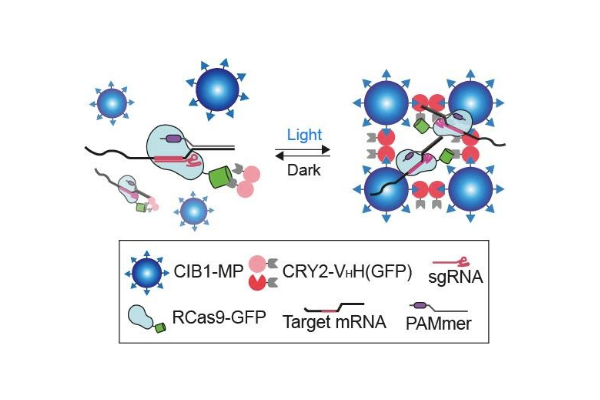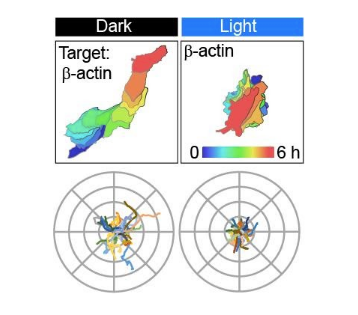Translation is the process of transferring genetic information from mRNA to protein. Numerous studies have demonstrated that mRNA translation is tightly related to mRNA localization. However, conventional methods are insufficient to fully address which mRNA molecules are responsible for which aspects of given cellular events. To directly investigate the causal relationship between the translation of specific mRNAs and various biological processes, Prof. Heo’s team developed an optogenetic method to achieve space and time-resolved control of specific molecules in live cells.
Dr. Kim Na Yeon Kim (the first author), JeongHye Yu (the second author) and Prof. Won Do Heo (the corresponding author), from the Department of Biological Sciences at KAIST (Bio-imaging and Optogenetics Lab), have developed a new optogenetic approach called mRNA-LARIAT (mRNA-light-activated reversible inactivation by assembled trap), combining the recently developed LARIAT system (Lee et al., 2014 in Nature Methods) with RNA binding protein (RBP)-based mRNA visualization modules to rapidly and reversibly trap specific mRNA into large protein clusters by light. Utilizing conventional mRNA visualization methods, and MS2 and RCas9 modules, the team demonstrated that mRNA-LARIAT can efficiently and reversibly trap specific exogenous and endogenous mRNAs in protein clusters. Sequestration of mRNAs interferes with translation by limiting dynamic interaction of ribosomes with sequestered mRNAs. The light-inducible reduction of translation was comparable to levels produced by chemical inhibitors.
In addition, the study demonstrated that mRNA-LARIAT provides a sensitive means for identifying endogenous RNA-binding complexes at the single-cell level. The highly amplified signals and simple experimental procedure of this method promise to address important questions regarding various aspects of RNA-protein interactions, the heterogeneous molecular composition of mRNA granules, and unidentified cis-acting elements in particular mRNAs.
Using this new method, the study illustrated that newly synthesized β-actin production is a critical determinant of cell-migration efficiency. Light-induced specific inhibition of β-actin translation effectively and reversibly attenuated cell motility. This is an interesting finding because, despite the presence of a large amount of pre-existing, long-lived (half-life, 48-72 hours) β-actin protein, inhibition of β-actin mRNA translation significantly perturbed cell migration within the short period of time, within 20 minutes. These results suggest that β-actin translation is constantly required for cell migration and the minute fraction of newly synthesized β-actin can have a profound effect on this process. The team also demonstrated that newly synthesized β-actin proteins are preferentially utilized by the formin-dependent pathway involved in the maturation process of focal adhesion over Arp2/3-driven membrane protrusion. Thus, the study proposed a model that makes a distinction between newly synthesized β-actin protein and pre-existing β-actin.
“mRNA-LARIAT is generally adaptable and able to rapidly and reversibly manipulate translation of target transcript, and can further be used to provide insight into how the function of different mRNAs are coordinated in space and time,” says Prof. Won Do Heo, leading author of this research.
The research was initiated by Professor Heo Won Do’s idea proposal and involved contributions by Dr. Kim Na Yeon (KAIST) and Dr. Lee Sang-gyu (Research Fellow, IBS Recognition and Sociality) to the process of presenting and optimizing optogenetic technologies that can directly inhibit the localization and translation of messenger RNA in cells.
The results of this research were published in Nature Chemical Biology (Impact Factor: 17.728), a prominent international journal in the field of Cell Biology, in February 2020.


Dr. Kim Na Yeon, Dr. Lee Sang-gyu, JeongHye Yu, and Prof. Won Do Heo Dept. of Biological Sciences, KAIST
Homepage: https://sites.google.com/view/heolab/home
E-mail: wondo@kaist.ac.kr






